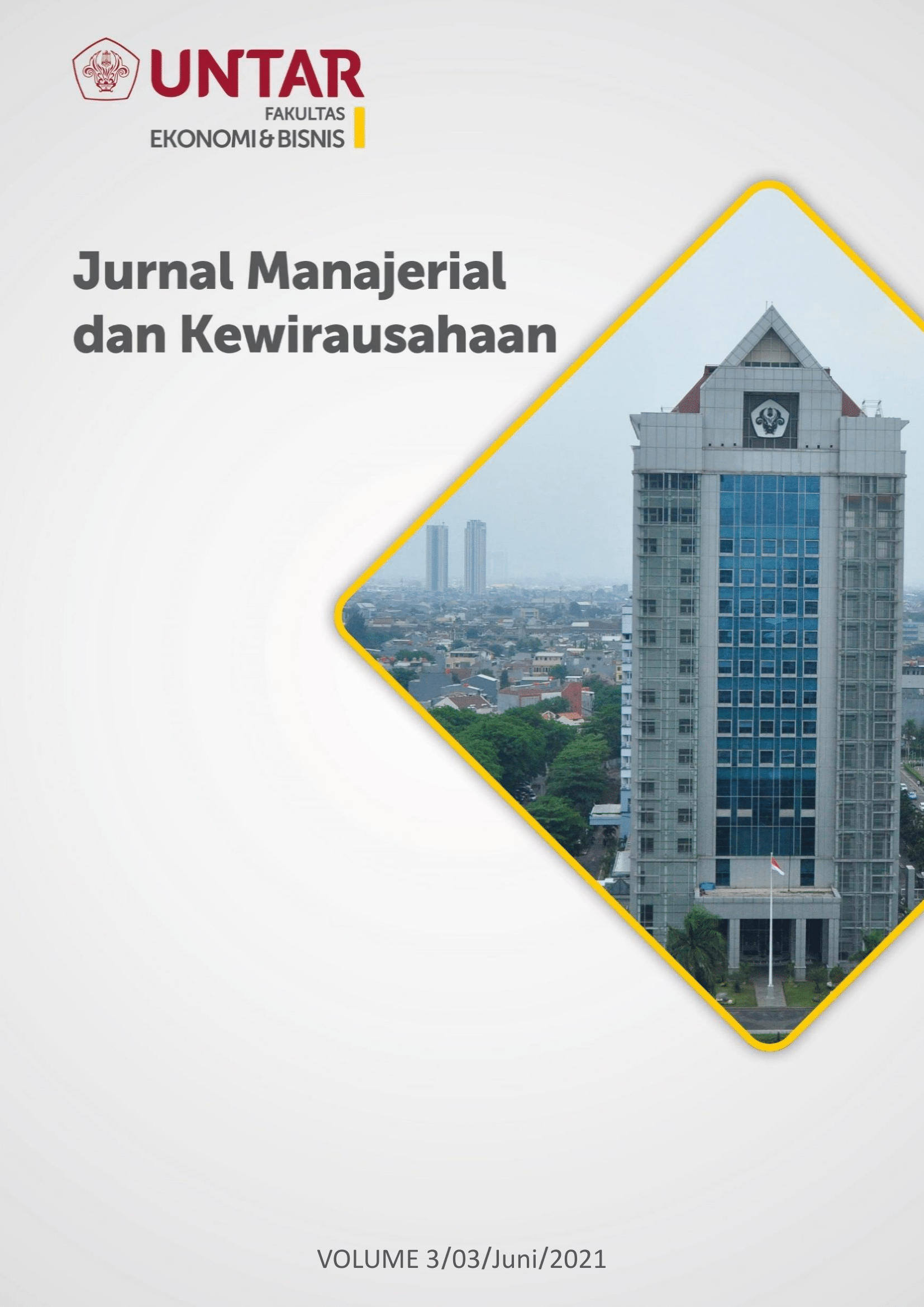Pengaruh Subjective Norm, Attitude Toward Behavior, Dan Self-Efficacy Terhadap Entrepreneurial Intention
Main Article Content
Abstract
The purpose of this study is to determine the influence of subjective norm toward entrepreneurial intention, attitude toward behaviour toward entrepreneurial intention, self-efficacy toward entrepreneurial intention. Sample was collected with non-probability sampling and purposive sampling. The data were collected using online questionnaire by google form with a total of 105 respondent and were processed by using SmartPLS software. The results of this study indicate that subjective norm affects entrepreneurial intention, attitude toward behaviour affects entrepreneurial intention, self-efficacy doesn’t affect entrepreneurial intention. The results of this study is to know how to increase entrepreneurial intention among private college student at West Jakarta with the help of three independent variables.
Tujuan dari penelitian ini untuk mengetahui pengaruh subjective norm pada entrepreneurial intention, pengaruh attitude toward behaviour pada entrepreneurial intention, pengaruh self-efficacy terhadap entrepreneurial intention. Teknik pemilihan sampel yang digunakan adalah non-probability sampling dan teknik pengambilan sampel adalah purposive sampling. Data diambil menggunakan kuisioner online melalui google form dengan jumlah total responden 105. Pengolahan data dilakukan dengan menggunakan software SmartPLS. Hasil penelitian ini yaitu subjective norm mempengaruhi entrepreneurial intention secara signifikan, attitude toward behaviour mempengaruhi entrepreneurial intention secara signifikan, self-efficacy tidak dapat mempengaruhi entrepreneurial intention. Hasil dari penelitian ini bertujuan untuk dapat mengetahui bagaimana cara meningkatkan intensi berwirausaha khususnya pada mahasiswa/i perguruan tinggi swasta di Jakarta Barat dengan penggunaan variabel independen yang ada.
Article Details
This work is licensed under a Jurnal Muara Ilmu Ekonomi dan Bisnis Creative Commons Attribution-ShareAlike 4.0 International License.,/p>
References
Abdillah, W. dan Hartono, J. (2015). Partial Least Square (PLS). Yogyakarta: Penerbit Andi.
Ajzen, I. (1989). Attitude structure and behavior. Attitude structure and function, 241, 274. ______, (1991).
The Theory of Planned Behavior. Organizational Behavior and Human ______, (2005). Attitudes, personality, and behavior.
McGraw-Hill Education (UK). ______, (2008). Attitudes and Attitude Change.
Psychology Press: WD Cranoeds ______,(1980).Understanding Attitudes and Predicting Social Behavior.
Englewoods Cliffs, NJ: Prentice Hall. Ajzen, I. and M. Fishbein. 1975. Belief, Attitude, Intention and Behaviour: An introduction to Theory and Research. California: Addison-Wesley.
Andika, M., & Madjid, I. (2012). Analisis pengaruh sikap, norma subyektif dan efikasi diri terhadap intensi berwirausaha pada mahasiswa Fakultas Ekonomi Universitas Syiah Kuala. In Eco-Entrepreneurship Seminar & Call for Paper" Improving Performance by Improving Environment.
Bandura, A. (2010). Self? efficacy. The Corsini encyclopedia of psychology, 1-3.
Byabashaija, Warren dan Katono, Isaac. (2011). The Impact of College Entrepreneurial Education on Entrepreneurial Attitudes and Intention to Start a Business in Uganda. Journal of Developmental Entrepreneurship. Vol. 16. No.1. 127-144.
Bougie, & Sekaran. (2013). Edisi 5, Research Methods for Business: A skill Building Approach. New York: John wiley@Sons
Boyd, N.G & Vozikis, G.S. (1994). The influence of self efficacy on the development of entrepreneurial intentions and actions. Entrepreneurship Theory and Practice, Summer.
Chin, W. W. (1998). The Partial Least Squares Approach to Structural Equation Modeling, In G.A. Marcoulides [ed.]. Modern Methods for Business Research. Mahwah: NJ: Lawrence Erlbaum Associates, Publisher.
Drennan, J., Kennedy, J., & Pisarski, A. (2005). Factors affecting student attitudes toward flexible online learning in management education. The Journal of Educational Research, 98(6), 331-338.
Eric W. Liguori (Rowan University, Glassboro, New Jersey, USA) Garson, G. D. (2016). “Partial Least Squares: Regression & Structural Equation Models”. Asheboro, USA: Statistical Publishing Associates
Ghozali, I. & Latan, H. (2012). Partial Least Square: Konsep, Teknik dan Aplikasi SmartPLS 2.0 M3. Semarang: Badan Penerbit Universitas
Diponegoro. Ghozali, I. (2006). Aplikasi analisis multivariate dengan program SPSS. Badan Penerbit Universitas Diponegoro.
Tenenhaus, M., Amato, S., & Esposito Vinzi, V. (2004, June). A global goodness-of-fit index for PLS structural equation modelling. In Proceedings of the XLII SIS scientific meeting (Vol. 1, No. 2, pp. 739-742).
Hair, J. F., Ringle, C. M., & Sarstedt, M. (2011). “PLS-SEM: Indeed a silver bullet. The Journal of Marketing Theory and Practice”, 19 (2), 139-152.
Henseler, J. R. (2009). The Use of Partial Least Square Path Modeling In International Marketing. New Challenges to International Marketing Advances in International Marketing, 277-319.
Indarti, N., & Rostiani, R. (2008). Intensi kewirausahaan mahasiswa: Studi perbandingan antara Indonesia, Jepang dan Norwegia. Jurnal ekonomika dan bisnis indonesia, 23(4), 1-27.
João J. Ferreira Mário L. Raposo Ricardo Gouveia Rodrigues Anabela Dinis Arminda do Paço, (2012),"Amodel of entrepreneurial intention", Journal of Small Business and Enterprise Development, Vol. 19 Iss 3pp. 424 – 440
Kasmir, 2011.Kewirausahaan–edisi revisi.Jakarta: PT.Raja Grafindo Persada.
Kuncoro, Mudrajad.2009. Metode Riset Untuk Bisnis & Ekonomi. Penerbit Erlangga. Jakarta.
Liadi F.N dan Budiono H. (2019). Pengaruh Dukungan Pendidikan, Sikap dan Efikasi Diri Terhadapa Intensi Kewirausahaan Pada Mahasiswa Semester Satu.
Linan, F. (2008). “Skill and Value Perceptions: How Do They Affect Entrepreneurial Intentions?”. International Entrepreneurship and Management Journal. 4, 257-272
Malhotra, N.K. (2012). Basic Marketing Research : Integration of Social Media. Jakarta : PT Index Kelompok Gramedia Ormrod, J. E. (2008). Human learning (5th ed.). Upper Saddle River, NJ: Pearson. Robledo, José Luis Ruizalba, et al. "The moderating role of gender on entrepreneurial intentions: A TPB perspective." Intangible capital 11.1 (2015): 92-117.
Santoso, S.A & Handoyo, S.E (2019). Pengaruh Sikap, Norma Subyektif, Kontrol Perilaku Yang Dirasakan, dan Orientasi Peran Gender terhadap Intensi Berwirausaha di Kalangan Mahasiswa Fakultas Ekonomi Universitas Tarumanagara.
Sekaran, U., 2006.Research methods for business – A skill-building approach. 4th ed. UK: John Wiley& Sons.
Sekaran, Uma. (2003). Research Methods for Business A Skill Building Approach.
New York John Wiley & Sons, Inc Stephan, W. G., & Finlay, K. (1999). The role of empathy in improving intergroup relations. Journal of Social issues, 55(4), 729-743.
Sugiyono, (2013). Metode Penelitian Kuantitatif, Kualitatif dan R&D. Bandung: Alfabeta.
Tung Moi, Yin Ling Adeline and Mui Ling Dyana, (2011), Young Adult Responses to Entrepreneurial Intent. Journal of Arts, Science & Commerce, Vol. –II, Issue –3, July 2011, pp-37-52
Wetzels, M., Odekerken-Schröder, G., & Van Oppen, C. (2009). Using PLS path modeling for assessing hierarchical construct models: Guidelines and empirical illustration. MIS quarterly, 177-195.
Zhao, H., Seibert, S. E., & Hills, G. E. (2005). The mediating role of selfefficacy in the development of entrepreneurial intentions. Journal of applied psychology, 90(6), 1265.



